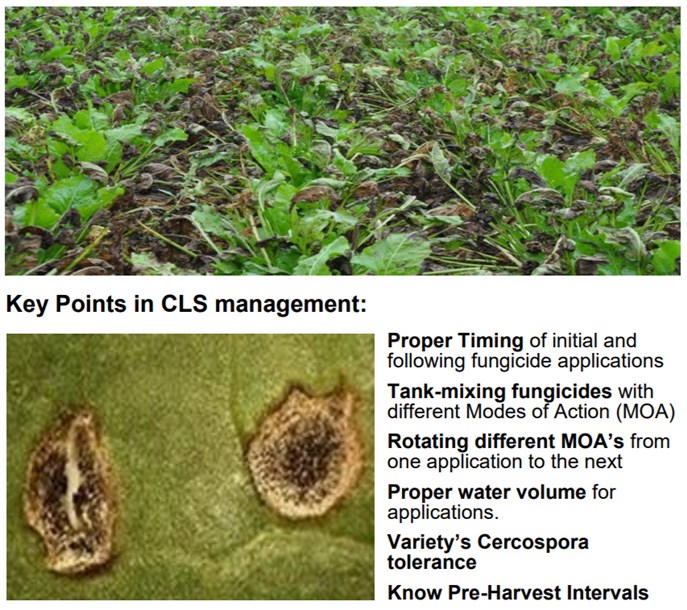612 - Cercospora Leafspot Management Notes
American Crystal’s Cercospora leafspot (CLS) fungicide recommendations are for both CLS control and resistance management. The goal is to keep Cercospora under control while at the same time keep the fungicides available to us working now and in future years. 2019 CLS management was successful in general, Cercospora was present in most areas but remained in check because the majority of growers are following these recommendations.

2020 ACSC Recommended Cercospora Leaf Spot (CLS) Spray Program and Modes of Action
Tips for Maximizing Cercospora Leafspot Control
- CLS variety rating – CLS control should improve with a better CLS variety rating. However, this may not equate to fewer fungicide applications.
- Daily Infection Values – Monitor Daily Infection Values (DIV’s) and weather forecasts for timing initial and following fungicide applications. Found on:
- Crystal Agronomy App
- NDAWN
- Scout fields – When DIV’s have reached Moderate to Severe levels scout for CLS presence. Continue scouting during the growing season to evaluate how your fungicide spray program is working.
- Timing of fungicide program – Start early and stay on track once CLS is found in your area. Cercospora Leaf Spot can appear 5 to 21 days after spore infection. Fungicides are protectants and being proactive by applying fungicides ahead of infection limits the development of Cercospora leaf spot.
- Pre-Pile & Fungicide Pre-Harvest Intervals – Be aware of each fungicide’s Pre-harvest Interval and how that may impact pre-pile harvest plans. Adjust your fungicide spray program accordingly.
- Water volume – CLS fungicides need excellent coverage to protect the sugarbeet leaf surface. To achieve this requires 15 to 20 gallons of water per acre.
- Dry leaves in the afternoon: 15–20 gallons/acre.
- Heavy dew on leaves in morning, consider 10-15 gallons/acre.
- Pressure – High pressure applications at 80+ psi provides improved leaf coverage depending on the spray tip chosen. Utilize nozzle manufacturer’s recommended application pressure for maximum leaf coverage.
- Spray nozzles/tips & droplet size– Using nozzles that will produce Medium droplet sizes of 250–350µm (microns) is optimum for fungicide applications. Utilize nozzle manufacturer’s recommended application pressure to operate within this range. Use proper spray boom height above crop canopy depending on chosen spray nozzle degree angle for best coverage.
- Aerial application – If too wet for ground application, stay on schedule with an aerial application. Also, if there are tank mixes you prefer not to use in your sprayer, consider aerial or custom ground application.
- Glyphosate tank mixes – Are not recommend with CLS fungicide applications since optimum water volume requirements are different for glyphosate and CLS fungicide applications as the target pests are not the same.
- Tank mixes – All fungicide applications should contain more than one chemistry or mode of action (only exception would be EBDC’s). Tank-mixing fungicide MOA’s and rotating MOA’s are paramount. Using only a single fungicide, MOA, increases resistance development pressure to that fungicide. Single fungicide applications may “get you by” but will increase and compound resistance to fungicides on your farm and surrounding neighbors. Utilizing all available fungicide chemistry wisely is vitally important for current fungicide options today and tomorrow. Any tank mix should be sprayed out as soon as possible, with agitation, do not allow mix to sit overnight, spray tank out completely, and rinse sprayer (all lines and tank) with clean water daily.
- Water temperature – Warm water is best for dissolving & mixing fungicides. Pre-warm water in dark bulk tanks a few days prior to use, sunlight aids in warming the water.
- Jar test – If in doubt about a tank mix, run a jar test to see if combination is compatible before loading sprayer.
- Full rates – In tank mixes utilize full application rates of each tank mix partner, following label recommendations.
- Spray intervals – The time interval between applications should not exceed 12 days, plan best as possible around adverse weather conditions (rain, wind, hail). For EBDC’s alone follow a 7-8 day spray interval.
American Crystal Agronomy App
Keep a close eye on Cercospora Leafspot development by monitoring Daily Infection Values.
The American Crystal Agronomy App is available and free, found at “the App Store” or “Google Play”.
CONTACT YOUR AGRICULTURIST
Contact your American Crystal Agriculturist for the most up-to-date information on issues affecting sugarbeets in your area.
